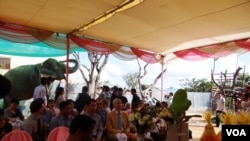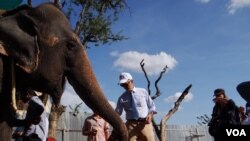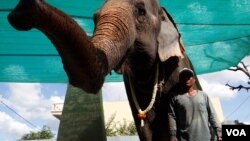Phnom Penh’s only Asian elephant is returning to the jungle after 30 years of service in the Cambodian capital.
Large crowds gathered Tuesday to celebrate the retirement and resettlement of the beloved Sambo, who has been a well known resident of Phnom Penh for half a century. A Buddhist religious ceremony was performed to mark her official release from captivity.
With support of the United States Agency for International Development (USAID), the 54-year-old elephant is set to relocate to the Elephant Valley Project (EVP) in the remote northeastern province of Mondolkiri next month.
There, she will join 12 other elephants in the Keo Seima forest under the supervision of a team from the Ministry of Agriculture’s Forestry Administration.
Sambo was brought to the city by the Sorn family nearly 50 years ago and has since become a staple of Cambodia’s Wat Phnom temple.
Her caretaker, Sin Sorn, says the elephant is also an important part of his family.
“My father caught her at Oral mountain in Kampong Speu province since I was a small kid,” he said. “This elephant and me are like siblings.”
USAID's Cambodia Deputy Director, Sean Callahan, is responsible for ensuring that financial assistance for Sambo’s release will contribute to preserving Cambodian wildlife.
“I think it's time that she enjoys her retirement,” said Callahan. “This is a little show of support to the Cambodian people and to the Cambodian wildlife and the need to preserve the wild diversity in the forest by just doing this.”
It is estimated that approximately 500 wild elephants live in Cambodian forests. Sambo is one of 78 domesticated elephants in the country.
The deputy director of the Cambodian Wildlife Protection Office, Keo Omalis, says he supports the move to the jungle.
“It is good to send Sambo back into the forest because here the space is not big enough for her," said Keo. "The elephants needs a big habitat in the forest with other elephants.”
The support of USAID, the Elephant Livelihood Initiative Environment (ELIE), and international donations is making Sambo’s transfer and resettlement possible.
This report was produced in collaboration with the VOA Khmer service.









